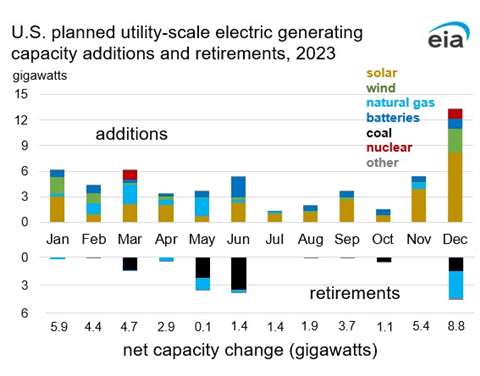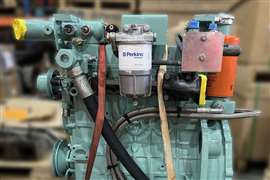New power projects soar in U.S.
28 February 2023
56.1 GW expected to be added in 2023

The U.S. power grid will add more than 56.1 GW of new utility-scale electric-generating capacity in 2023, the largest amount of added capacity since 2002, according to the U.S. Energy Information Administration (EIA).
The EIA expects about 14.5 GW of capacity to be retired in 2023, resulting in a net capacity gain of nearly 41.6 GW, the largest change since 2003.
More than half (52%) of capacity additions will be solar, followed by battery storage at 17%. Coal-fired units account for 8.9 GW (62%) of the total 14.5 GW of capacity scheduled to be retired, followed by 5.2 GW (36%) of natural gas-fired units set to close.
“Despite its upward trend over the past decade, additions of utility-scale solar capacity declined by 23% in 2022 compared with 2021 because of supply chain disruptions and other pandemic-related challenges,” the EIA said. “We expect that some of those delayed 2022 projects will begin operation in 2023, when 29 GW of utility-scale solar is expected to be added. If all of this capacity comes online as planned, 2023 will add the most utility-scale solar capacity to the U.S. power grid in a single year, more than doubling the 13.4 GW added in 2021, the current record.”
In 2023, U.S. battery capacity will likely more than double, with another 9.5 GW of battery storage added to the existing 8.8 GW of battery storage capacity. Fully 73% of the new battery storage capacity will be in California and Texas, states with significant solar and wind capacity.
Natural gas will account for 7.8 GW of new capacity, 80% of which is from combined-cycle plants. The two largest natural gas plants expected to come online in 2023 are the 1,836 MW Guernsey Power Station in Ohio and the 1,214 MW CPV Three Rivers Energy Center in Illinois.
In 2023, 7.5 GW of utility-scale wind capacity is expected to be added to the grid.
“The pace of annual U.S. wind capacity additions has slowed, following record additions of more than 14 GW in both 2020 and 2021,” according to the EIA. “The most wind capacity will be added in Texas in 2023, at 2.2 GW.”
A single offshore wind facility is expected to come online this year: the 130 MW South Fork Wind facility off the coast of Long Island, New York.
Two new nuclear reactors at the Vogtle nuclear power plant in Georgia are scheduled to come online in 2023, several years later than originally planned. The reactors, with a combined 2.2 GW of capacity, are the first next generation design nuclear units built in the United States.
The EIA said a substantial amount of U.S. coal-fired capacity has retired over the past decade, including a record 14.9 GW in 2015. Annual coal retirements decreased to 5.6 GW in 2021 after averaging 11.0 GW a year from 2015 to 2020, before increasing to 11.5 GW in 2022. This year, 8.9 GW of coal-fired capacity is expected to retire, which is 4.5% of the total coal-fired capacity at the start of the year.
The largest coal plant expected to retire this year is the 1,490 MW W.H. Sammis Power Plant in Ohio. Pleasants Power Station (1,278 MW) in West Virginia is the second-largest coal plant retirement expected this year.
This year, 5.2 GW of U.S. natural gas-fired capacity is scheduled to retire, representing 1% of the operating natural gas fleet as of January, the EIA said. Most of the retiring natural gas capacity is made up of older steam and combustion turbine units.
Power plants fueled by natural gas slated for retirement in 2023 mostly have been kept in reserve to meet power demand during peak periods. As a result, the 5.2 GW of natural gas-fired capacity scheduled to retire operated, on average, at a 7% capacity factor in 2021. The situation is different for coal-fired plants slated for closure in 2023 because the average capacity factor for those plants was much higher at 26%.
POWER SOURCING GUIDE
The trusted reference and buyer’s guide for 83 years
The original “desktop search engine,” guiding nearly 10,000 users in more than 90 countries it is the primary reference for specifications and details on all the components that go into engine systems.
Visit Now
STAY CONNECTED




Receive the information you need when you need it through our world-leading magazines, newsletters and daily briefings.
CONNECT WITH THE TEAM













